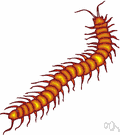myriapod
Also found in: Thesaurus, Medical, Encyclopedia, Wikipedia.
myr·i·a·pod
also myr·i·o·pod (mĭr′ē-ə-pŏd′)n.
Any of numerous arthropods of the subphylum Myriapoda, having segmented bodies, one pair of antennae, and at least nine pairs of legs, and including the centipedes and millipedes.
[From New Latin Mȳriapoda, class name : Greek mūrias, ten thousand; see myriad + New Latin -poda, -pod.]
myr′i·ap′o·dous (-ăp′ə-dəs) adj.
American Heritage® Dictionary of the English Language, Fifth Edition. Copyright © 2016 by Houghton Mifflin Harcourt Publishing Company. Published by Houghton Mifflin Harcourt Publishing Company. All rights reserved.
myriapod
(ˈmɪrɪəˌpɒd)n
(Animals) any terrestrial arthropod of the group Myriapoda, having a long segmented body and many walking limbs: includes the centipedes and millipedes
adj
(Animals) of, relating to, or belonging to the Myriapoda
[C19: from New Latin Myriapoda. See myriad, -pod]
myriapodan adj
ˌmyriˈapodous adj
Collins English Dictionary – Complete and Unabridged, 12th Edition 2014 © HarperCollins Publishers 1991, 1994, 1998, 2000, 2003, 2006, 2007, 2009, 2011, 2014
myr•i•a•pod
or myr•i•o•pod
(ˈmɪr i əˌpɒd)n.
any arthropod having an elongated segmented body with numerous paired, jointed legs, as a centipede or millipede.
Random House Kernerman Webster's College Dictionary, © 2010 K Dictionaries Ltd. Copyright 2005, 1997, 1991 by Random House, Inc. All rights reserved.
ThesaurusAntonymsRelated WordsSynonymsLegend:
Switch to new thesaurus
| Noun | 1. |  myriapod - general term for any terrestrial arthropod having an elongated body composed of many similar segments: e.g. centipedes and millipedes myriapod - general term for any terrestrial arthropod having an elongated body composed of many similar segments: e.g. centipedes and millipedesarthropod - invertebrate having jointed limbs and a segmented body with an exoskeleton made of chitin |
Based on WordNet 3.0, Farlex clipart collection. © 2003-2012 Princeton University, Farlex Inc.
Translations